I wonder how often a picture book biographer has been friends with her subject for several decades and then worked closely with that person to get her manuscript just right. I’m curious about the process of working with a living person and having direct access.
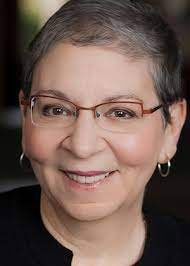
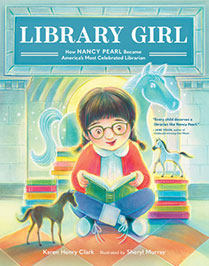
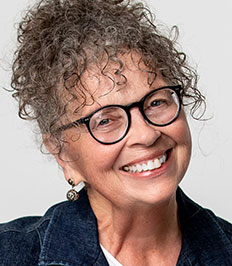
The book is Library Girl: How Nancy Pearl Became America’s Most Celebrated Librarian, written by Karen Henry Clark, illustrated by Sheryl Murray, and published by little bigfoot.
The subject of this biography, Nancy Pearl, has written books about books (Book Lust and Book Crush), as well as The Writer’s Library: The Authors You Love on the Books That Changed Their Lives (written with Jeff Schwager) and George and Lizzie: A Novel. Nancy was a librarian in Detroit, Tulsa, and Seattle. She founded “If All Seattle Read the Same Book,” a pioneering community book discussion program, and gave book reviews and interviewed authors on KUOW and KWGS radio along with CNN and NPR. You may have attended one of her enlightening talks about books. Or perhaps you’re admiring your Nancy Pearl Librarian action figure, reminding yourself that librarians are superheroes.
Karen Henry Clark, the author of Library Girl, worked with Nancy Pearl at a bookstore in Tulsa, Oklahoma, where they became friends. Karen is the author of Sweet Moon Baby: an Adoption Tale (Knopf). Library Girl is her second book. We’re thankful she wrote it for us.
Karen, where were you in time and space when you thought about writing a picture book biography of your friend and national super-librarian, Nancy Pearl?
In 2011 I attended one of her packed-auditorium speaking events in Minneapolis (I lived in St. Paul then.) and witnessed her incredible ability to charm, inform, and inspire an audience, whether they were readers or not. When the program ended, in no uncertain term, fans lined the aisles for selfies with her or for her autograph on her successful Book Lust. Because I knew about Nancy’s complicated childhood, I was thrilled to see she’d overcome those unhappy years. Here’s a story with universal appeal, I realized.
Karen, how did you approach Nancy about your idea?
I visited Nancy in Seattle in 2012. One afternoon in her living room, I presented my idea and asked her if I could try. By then I’d published my first picture book, Sweet Moon Baby, about adopting our daughter Maggie from China. Nancy loved the book and had always believed, since our early days of working in a Tulsa bookstore, that I was a writer. Of course, I had always believed the same about her. She was initially reluctant to recall those hard childhood times, but she agreed to let me try.
Nancy, what did you think when Karen suggested you as a subject of a picture book?
I thought that it would be great, because not only do I think that Karen’s a wonderful writer, but that in telling my story, it would also be the story of every other kid who loved books and reading and found acceptance and happiness at his/her/their public and school library.
Karen, I’ve read in other interviews that you took part in a workshop led by Jane Yolen, national super-author, that helped to move you forward with this project. Specifically, what changed for you during that workshop?
By 2015, I’d given up on the manuscript, having turned it every which way. But as a mother, I realized if I gave up on a dream, I’d be teaching Maggie the wrong lesson. It was a desperate click on another author’s blog that landed me on the page about Jane’s Picture Book Boot Camp. I applied, thinking I didn’t stand a chance of being accepted. I was. She overheard me tell our guest speaker, a librarian, that I was trying to write about Nancy Pearl. Jane interrupted to say, “That will sell.” I was shocked. Jane hadn’t read a word of my “mess.” The next day her presentation was about NOT giving up. I lowered my head. She said, “Do you hear me?” I looked up, terrified. Jane leveled me with those penetrating, all-knowing eyes and said, “I’m talking to you.” No one wants to disappoint Jane Yolen. I promised to try again.
Nancy, you have authored a novel, books recommending books for adults and children, and you have interviewed dozens (hundreds?) of authors. How did it feel to work closely with an author of a book about you?
Karen and I have known each other since we both lived in Tulsa, Oklahoma in the 1980s, and over the years we’ve shared a good bit of our own histories, but it was interestingly different when Karen would call me with a list of specific questions about my childhood- it was a little shocking both how much I remembered and how much I had forgotten.
Nancy, did you read Karen’s manuscript several times? How did you offer encouragement?
I think I read an early draft of the book and offered some suggestions, but then I think I didn’t read it until Karen felt it was finished and was ready to offer it to agents/publishers.
Karen, were there parts of Nancy’s childhood that she asked you not to include in your book? Did that present a challenge for the storytelling?
Because she asked me not to mention her family, I focused on her experience of not being understood by classmates for her devotion to books. I interviewed her countless times, searching for the necessary dots to build a plot. Any of us would struggle to recall the details of being eight years old, and I admit it felt hopeless at times. Fortunately, my new draft allowed critique partners to ask valuable questions that let me narrow my questions for Nancy. Bit by bit, her memories returned — the three devoted librarians, the fantastic bike Charger, the enchanting Francis Parkman Branch Library, and the assignment that forced her to find courage.
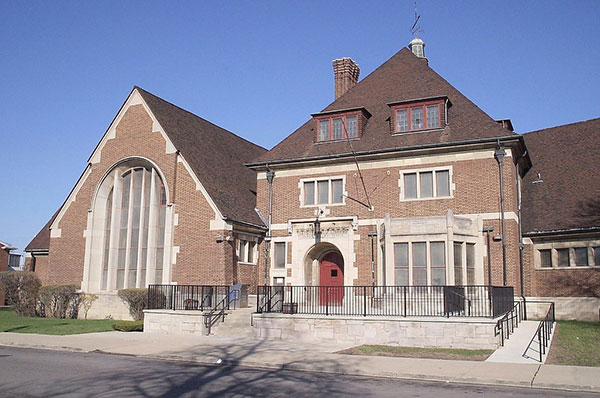
Nancy, how did you acclimate yourself to the idea of your childhood being presented to readers everywhere?
In my public presentations I’ve been pretty open about how my (I always think of the Parkman Branch Library in Detroit as “my”) library and the two children’s librarians there were so wonderfully kind and supportive of this basically miserably unhappy kid that I was, and how they gave me the world through the books they wanted me to read, so it wasn’t too much of a change to have it down in the pages of the book. I don’t think I’ve ever shared with anyone outside my family before the story of our neighborhood milkman giving me a ride to the library with all my model horses, and that was fun to see it got included in the book. Mostly, though, and probably weirdly, I think of the heroine of Library Girl as she, and not me.
Karen, did you confer with the illustrator, Sheryl Murray, before you received the galleys? (A galley is the mock-up of the printed book, with illustrations and words laid out on the page for the final book, but offering a chance for corrections to be made.)
No. My editor sent me to Sheryl’s website. I saw her potential for capturing irresistible facial expressions and whimsical settings. The art editor then sent Sheryl the manuscript, and she was determined to do it because she’d been a library girl as a child.
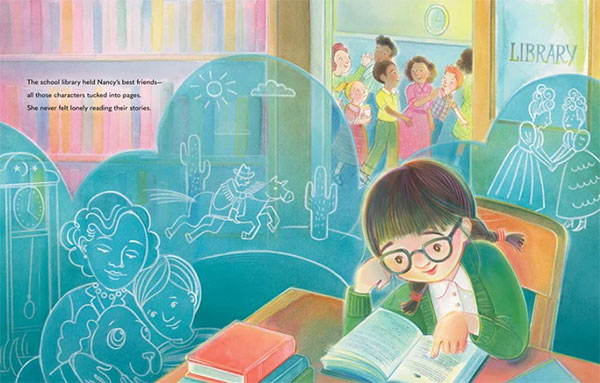
Karen, once the galleys arrived, did you offer Nancy an opportunity to weigh in about them?
Absolutely. I could hardly wait. Those galleys astonished me. Sheryl’s vision for the story surpassed anything I’d imagined. Those incredible blue horses are never mentioned in the text, but Sheryl captured them. And she brought an entire building to life. I knew Nancy would love them. Because it was her story, we all wanted her to be comfortable with the sentences and illustrations. So every page was passed back and forth.
Nancy, how did it feel to see your childhood in the illustrations of a picture book?
I absolutely love the illustrations — Sheryl Murray really understood the book and the power of imagination — the scene with Nancy under the table in the library just brought back so many memories to me, not to mention how she captured how the library looked to me when I was a child.
Karen and Nancy, what is your best hope for Library Girl?
Karen: I hope children will feel encouraged to overcome a hard challenge by searching for the thing that makes them feel brave — just like Nancy did. That’s how confidence develops. Fred Rogers, of Mr. Rogers’ Neighborhood, assured us that helpers were always present, and it doesn’t matter if they’re real or imaginary. Believe in them.
Nancy: Every time I tell my story people come up to me afterwards to say that their childhood and the role libraries played in their lives was the same as mine — I hope (and believe) that the combination of Karen’s words and Sheryl’s photos will help kids feel about the library and books and reading the way that I did.
Thank you both for allowing us to look inside the creation of this particular picture book that shares the experience of kids who find light and hope and a way forward within the libraries of our world. You’ve given a gift to those of us who are those kids.

Vicki, thank you for including the photo of Detroit’s Francis Parkman Library. Their archivist graciously sent me interior shots of the building during her time there. The book also depicts Nancy’s Haley Grade School, and I found her actual childhood home – the yellow one behind Mr. Fishoff. Nancy also provided descriptions of the librarians and their fashion tastes. And she really had a blue dress with white flowers.